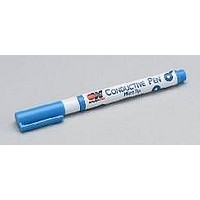CW2200MTP Chemtronics, CW2200MTP Datasheet - Page 3

CW2200MTP
Manufacturer Part Number
CW2200MTP
Description
Soldering Tools MICRO-TIP PEN
Manufacturer
Chemtronics
Type
Conductive Pensr
Datasheet
1.CW2200MTP.pdf
(4 pages)
Specifications of CW2200MTP
Boiling Point
259 to 378 °F
Chemical Component
Acrylic Resin/Ethylene Glycol Monobutyl Ether Acetate/n-Butyl Acetate/Propylene Glycol Methyl Ether Acetate/Silver
Dispensing Method
Pen
Flash Point
76 °F (TCC)
Hydrolytic Stability
Stable
Pressure, Vapor
5 to 6 mmHg @ +20 °C
Primary Type
Coating
Special Features
Repair
Specific Gravity
1.8 to 2.0
Temperature, Rating
+205 °C
Time, Setting
<2mm/hr.
Weight
0.3 Oz.
Maximum Temperature
+ 400 F
Description/function
Draws highly conductive silver traces, jumpers and shielding
Product
Soldering Accessories
Lead Free Status / RoHS Status
Lead free / RoHS Compliant
ITW CHEMTRONICS ®
SECTION 1: CHEMICAL PRODUCT AND COMPANY INFORMATION
Product Code: CW2200MTP, CW2200STP, CW2200BLK
SECTION 2: COMPOSITION/INFORMATION ON INGREDIENTS
Chemical Name
Silver
Propylene Glycol Methyl Ether Acetate
Ethylene Glycol Monobutyl Ether Acetate
n-Butyl Acetate
Acrylic Resin
SECTION 3: HAZARDOUS IDENTIFICATION
Emergency Overview: Silver colored paint with an aromatic hydrocarbon odor. This product is flammable. Liquid and vapors will irritate eyes and skin. Breathing
high concentrations of product may produce headache, nausea, and drowsiness.
Potential Health Effects:
Eyes: Vapors of this product may irritate the eyes. Liquid is irritating and may cause tearing, redness, swelling or temporary corneal damage.
Skin: Contact may cause irritation. prolonged contact may cause dermatitis.
Ingestion: Harmful if swallowed. May cause nervous system depression.
Inhalation: Harmful if inhaled. May cause headache, nausea, vomiting, dizziness, drowsiness, irritation of the respiratory tract/mucous membranes. Extreme over-
exposure may cause loss of consciousness and narcosis.
Pre-Existing Medical Conditions Aggravated by Exposure: Heart, lung, eye, skin.
SECTION 4: FIRST AID MEASURES
Eyes: Immediately flush with large amounts of water. After initial flushing, remove any contact lenses and continue flushing for at least 15 minutes. Have eyes
examined by a physician if discomfort persists.
Skin: Remove contaminated clothing and wash skin with soap and water. Get medical attention if irritation develops or persists. Wash clothing separately before
reuse.
Ingestion: If swallowed, give two or more glasses of water immediately. DO NOT induce vomiting. Get medical attention.
Inhalation: In case of exposure to high concentrations of vapor or mist, remove to fresh air. If breathing is difficult, give oxygen and call a Physician. If breathing has
stopped, apply artificial respiration and call a Physician.
SECTION 5: FIRE FIGHTING MEASURES
Flash Point: 76°F (24C) (TCC)
Extinguishing Media: Use alcohol foam, water foam, carbon dioxide, dry chemical, or water spray. Water may not be effective in fighting the fire but can be used to
cool overheated areas. Care must be taken to not spread the fire.
Fire Fighting Instructions: Remove all ignition sources. Use water spray to cool overheated containers. Take care not the spread fire with water. As in any fire, wear
self-contained breathing apparatus (pressure demand, OSHA/NIOSH approved or equivalent) and full protective gear. Solvent vapors are an explosion hazard. Keep
material away from all sources of ignition, extreme heat, sparks or open flame. Material can be easily ignited and burns with intense heat.
SECTION 6: ACCIDENTAL RELEASE MEASURES
Large Spills: Remove all sources of ignition (sparks, open flames, etc.). Wear self-contained breathing apparatus and appropriate personal protective equipment.
Ventilate area and contain and absorb spill with inert material. Collect spill by scooping up liquids and absorbent material and place in a chemical waste container for
proper disposal. Do not flush to sewer. Prevent material from entering storm sewers, ditches that lead to waterways and ground.
Small Spills: Absorb spill with absorbent material, then place in a chemical waste container for proper disposal.
SECTION 7: HANDLING AND STORAGE
Avoid prolonged or repeated contact with skin, eyes or clothing. Wash hands before eating. Use with adequate ventilation. Avoid breathing product vapor. Do not
reuse this container. Store in a cool dry place, away from heat, sparks or flames. Keep container tightly closed when not in use. Do not store in direct sunlight.
KEEP OUT OF REACH OF CHILDREN.
SECTION 8: EXPOSURE CONTROLS, PERSONAL PROTECTION
Exposure Guidelines:
CHEMICAL NAME
Silver
Propylene Glycol Methyl Ether Acetate
Ethylene Glycol Monobutyl Ether Acetate
n-Butyl Acetate
Acrylic Resin
Work/Hygienic Practices: Good general ventilation should be sufficient to control airborne levels. Local exhaust ventilation may be necessary to control any air
contaminants to within their TLVs during the use of this product. If vapor concentration exceeds TLV, use NIOSH approved organic vapor cartridge respirator. Wear
safety glasses with side shields or goggles and rubber or other chemically resistant gloves when handling this material.
NFPA and HMIS Codes:
Health
Flammability
Reactivity
Personal Protection
Product Identification
Product Information: 800-TECH-401
LEL/UEL: 1.5/10.0 (% by volume in air)
CIRCUITWORKS
7440-22-4
ACGIH TLV
NFPA
123-86-4
150 ppm
0.1 mg/m3
108-65-6
NA
112-07-2
Page 1 of 2
NA
CAS No.
mixture
NA
-
2
3
1
®
CONDUCTIVE PEN
150 ppm
OSHA PEL
0.01mg/m3
NA
NA
NA
HMIS
B
2
3
1
35.0-65.0
5.0-35.0
15.0-40.0
Wt. % Range
2.0-20.0
2.0-20.0
ACGIH STEL
NA
NA
NA
NA
200 ppm
MSDS #4001



